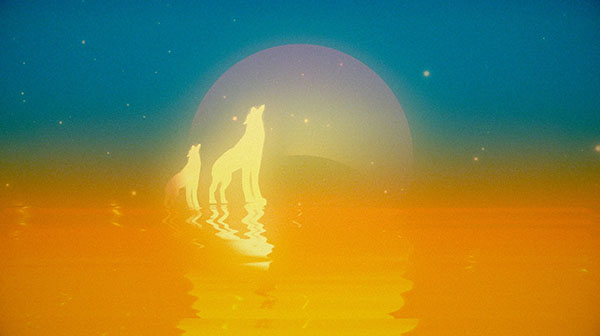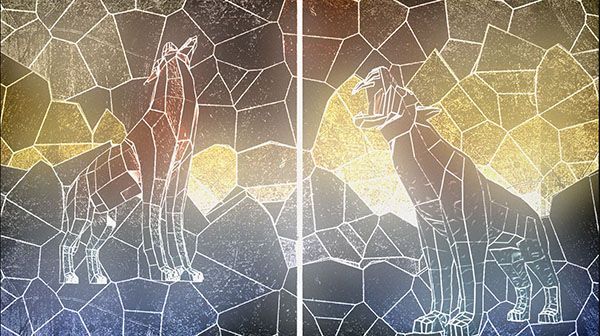Composer Sarah Kirkland Snider has shared a video for "Gloria" from her album Mass for the Endangered. The video by CandyStations, aka Deborah Johnson—the fifth video in the series for the album from Johnson—can be seen here; a special interactive version, made with Louise Lessél, is also available.
Composer Sarah Kirkland Snider has shared a video for "Gloria" from her album Mass for the Endangered, released to critical acclaim on New Amsterdam and Nonesuch Records in 2020. The video by CandyStations, aka Deborah Johnson, which I Care If You Listen called "stunning," can be seen below, and a special interactive version, made with Louise Lessél, is available on Snider's website.
Of the meaning behind "Gloria," Snider says: "In most traditional settings of the Catholic Mass, the Gloria movement is grand and celebratory, a salute to the Lord Jesus and His Glory. But when I read the translation of the Latin and imagined endangered wildlife in the place of God and/or Jesus, the text actually struck me as tender and wistful—particularly its repetition of 'you alone,' which took on new meaning in the context of species extinction. Instead of, 'For you alone are the Holy One, you alone are the Lord, you alone are the Most High,' I imagined, 'You alone are the Bengal tiger, You alone are the polar bear, You alone are the red wolf.' In other words, each species is unique and irreplaceable. I thought about the relationship between Mother and Child, the cycle of nurturing that keeps the species alive, as well as that between Mother Earth and each living creature. Imagining the text this way led me to see the entire movement as an expression of deep affection for all wildlife, and gratitude to the Earth for its nurture and sustenance."

Regarding the video and interactive piece, Johnson says: "I wanted to bring audio responsiveness, a technique I often use in live performance, to a movement for Mass. The prolific use of the harp in 'Gloria' felt like the right moment for it—the singular, plaintive notes conjured a similarly emotive visual instrument. 'Gloria' is a meditation on the singular beings of our threatened, endangered animals and their protective mamas—that of species and Mother Earth. I chose to focus on endangered animals' ancestors for both pieces, imagining a luminous journey through space and time. But time is a fire for all beings. Eclipsed from existence, they are preserved and memorialized in crystallized earth, glorified by Gaia. The interactive piece explores human intervention and excavation, revealing evidence of one's influence, a poetic and dynamic sister to the official video."

On the interactive version of the video, sacred creatures emerge and erode through a mouse and audio-responsive mosaic that evokes Byzantine patterns, stained glass motifs, and ancient rock formations. Users can click and drag to alter the rocky facets, simultaneously revealing and eroding the underlying animal forms. As the music fades, a final, ghostly image reveals all the marks made.
This is the fifth video in the series for the album from Johnson, following "Credo," "Alleluia," "Kyrie," and "Sanctus/Benedictus."
Mass for the Endangered, with a libretto by poet/writer Nathaniel Bellows, is a celebration of, and an elegy for, the natural world—animals, plants, insects, the planet itself—an appeal for greater awareness, urgency, and action. Originally commissioned by Trinity Church Wall Street, the recording features the English vocal ensemble Gallicantus conducted by Gabriel Crouch. The New Yorker says it "proclaims Snider's technical command and unerring knack for breahttaking beauty." NPR says: "Through her smart and resplendent exploration of age-old musical formals, Snider's eco-inspired Mass for the Endangered is a blast from the past that resonates profoundly in the present."
Deborah Johnson, who has previously worked with artists like Sufjan Stevens, eighth blackbird, Bryce Dessner, Nico Muhly, Bang On A Can, and Wilco, presents a unified and distinctive vision to accompany the music of Snider’s Mass: the full six videos are viewed as a ‘Cathedral of the Cosmos,’ honoring and receiving the animal and plant species that no longer find life on Earth sustainable. The videos draw from architectural elements of cathedrals, and grow in complexity with each video.
“One of my favorite aspects of this collaboration has been learning about Deborah’s creative process and getting to peek behind-the-scenes at how she makes her art. I was really struck by the thoughtfulness and sensitivity with which her animations inhabit the architecture and pacing of the score,” Snider writes in an essay for the Nonesuch Journal on working with Johnson. “Working with Deborah on Mass for the Endangered has been one of the more satisfying and enriching collaborations I’ve experienced. I love that I don’t know what’s next to come in this poetic, layered, phantasmagorical story she’s creating, and I can’t wait to see how it expands and deepens my understanding of the music.”
- Log in to post comments



